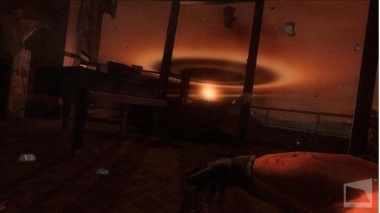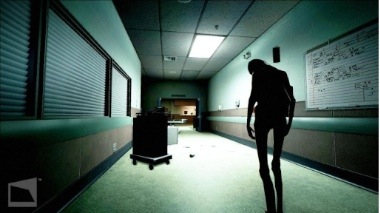Let’s not delude ourselves any more than necessary. F.E.A.R. 2 is little more than a long string of horror movie and shooter cliches strung together into one tidy package.
Stop me if any of this sounds familiar: creepy little girl, long black hair, scientific experiments gone awry, traveling through subways, hospitals, and elementary schools...
You get the picture.
But as such, it becomes a prime example of how a game can be perfectly enjoyable despite not bringing much new to the table.
 In F.E.A.R. 2, you play as a different character than the undoubtedly poorly-fated soul you inhabited in the first game. This fresh perspective on the world allows the game to retell and clarify much of the backstory. F.E.A.R. 2 even begins before the ending of the first game. Far from seeming redundant, this recapping actually managed to tell many of the hazy details of the first outing better than the original, so it is much appreciated.
In F.E.A.R. 2, you play as a different character than the undoubtedly poorly-fated soul you inhabited in the first game. This fresh perspective on the world allows the game to retell and clarify much of the backstory. F.E.A.R. 2 even begins before the ending of the first game. Far from seeming redundant, this recapping actually managed to tell many of the hazy details of the first outing better than the original, so it is much appreciated.
Our dear little psychotic Alma is now all grown up, on the loose, and seriously pissed off. You will spend most of the game chasing after her and trying to put an end to her shenanigans. That’s pretty much what you need to know. It’s a simple setup, but since the game carries the added burden of making sense of the original’s heap of poorly-told nonsense anything more would have bogged it down too much.
Not to worry though, as there are plenty of twists and turns in store and the yarn is much more satisfying and clearly delivered than in the first game.
 The gameplay will also seem familiar, but in a pleasant, comfort food sort of way. Not much has changed, but it’s so well crafted that it didn’t really need to. A few new guns are added to the mix, the AI has received a notable boost in intelligence, and you can now make cover for yourself in case you ever felt jealous of the enemy’s ability to do so in the original F.E.A.R.
The gameplay will also seem familiar, but in a pleasant, comfort food sort of way. Not much has changed, but it’s so well crafted that it didn’t really need to. A few new guns are added to the mix, the AI has received a notable boost in intelligence, and you can now make cover for yourself in case you ever felt jealous of the enemy’s ability to do so in the original F.E.A.R.
The combat isn’t terribly original, like the rest of the game, but it’s immensely satisfying and provides that perfect roller coaster of fear, tension, and release as the game moves from scary bit to action bit. Adding to this are a couple of sections where the player is given the opportunity to control a mech and mow down legions of enemies. Monolith has totally nailed the sensation of piloting one of these things like no other game I can remember, and if these mechanics aren’t fleshed out into a full game it will be a true shame.
 Even the slow-mo, which could feel seriously dated, unnecessary, and overused, remains great fun. It’s hard to define exactly why slowing time and blasting foes into tiny bloody bits never gets old in this game when it wears thin so quickly in so many others.
Even the slow-mo, which could feel seriously dated, unnecessary, and overused, remains great fun. It’s hard to define exactly why slowing time and blasting foes into tiny bloody bits never gets old in this game when it wears thin so quickly in so many others.
The gorgeous graphics and terrifically disturbing blood effects certainly don’t hurt. This is one extremely gory, visceral game. In fact, the presentation here is easily one of its biggest strengths, from sound design to graphics to special effects. The whole shebang is quite an impressive package.
Occasionally, however, the lights do shine a little too brightly in this haunted house and expose a few of the more shoddily built props for the cheap skeletons they really are.
Most notably for fans of the original F.E.A.R., Monolith doesn’t seem to have learned too many new scare tactics for this newest outing. Alma still pops up randomly, lights flicker on and off, and hallucinations haunt you from time to time. The entertaining “dream” sequences from the prior outing are also more infrequent than I would have liked.
 This, by far and away, is my biggest complaint. The atmosphere is stellar, the shooting is just as fun, and the environments more varied, yet this one fault comes dangerously close to making the game feel uninspired.
This, by far and away, is my biggest complaint. The atmosphere is stellar, the shooting is just as fun, and the environments more varied, yet this one fault comes dangerously close to making the game feel uninspired.
All is not lost, however. The game certainly does have enough cool, creepy, and even genuinely scary moments to keep you on the edge of your seat. I’m not about to spoil them here, but there are definitely some treats in store.
Monolith has thankfully addressed one of the biggest complaints about the original F.E.A.R., and to great effect. The environments are both impressively detailed and varied. Gone are the days of the endless series of cloned office corridors. Sure we may have seen the themes before, but never once did they feel sterile or uninspired, as if they simply chose these overdone location themes because they couldn’t think of anything better. All of them served their intended purpose and were suitably creepy, unnerving, and memorable.
 Also, other games should pay attention to F.E.A.R. 2 when it comes to endings. It’s no secret that few horror stories, no matter the medium, actually end properly. The first F.E.A.R. was certainly an example of this and the sequel is no different.
Also, other games should pay attention to F.E.A.R. 2 when it comes to endings. It’s no secret that few horror stories, no matter the medium, actually end properly. The first F.E.A.R. was certainly an example of this and the sequel is no different.
What separates Monolith’s two games from the rest of the crappy horror endings (and indeed the innumerable games of late that seem to relish in not having an ending, instead choosing to set things up for the inevitable sequel) is how well they are constructed. In the first F.E.A.R., you knew Alma was far from gone and the story far from over, but the arc of your particular character, and that of the game’s slice of the overall story, had been told and concluded, in suitably epic fashion.
F.E.A.R. 2 is even more of a cliffhanger than the first game, but the ending is so spectacular that it doesn’t matter. The entire sequence, from the last level to the final confrontation to the story twist saved for the very last moments, is one of the outright coolest endings I can remember playing in a long time.
 I can only hope that the, yes, inevitable sequel will make good on it, because they’ve already sold me.
I can only hope that the, yes, inevitable sequel will make good on it, because they’ve already sold me.
So while it may not be astoundingly original, while it may have lost a little bit of its fright factor compared to the first game, and while it could still be accurately described as a “ride” just as much as a “game” at times, it is still an experience most certainly worth undertaking for those that fit its target audience. There’s nothing wrong with creating something that’s simply fun, and that’s what F.E.A.R. 2 is: a fun experience that, for the right audience, will provide thrills, chills, and plenty of memorable moments.
 For those that don’t fit its target audience, well, I feel sorry for you, because if this game is a ride, it’s a hell of a trip that will leave you wanting more at the end. And that’s what any good story should do.
For those that don’t fit its target audience, well, I feel sorry for you, because if this game is a ride, it’s a hell of a trip that will leave you wanting more at the end. And that’s what any good story should do.